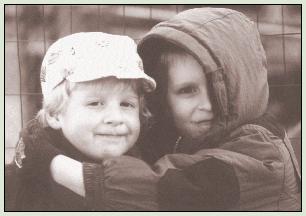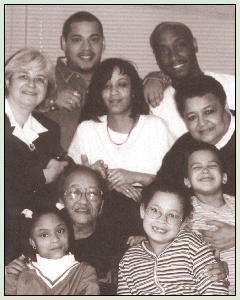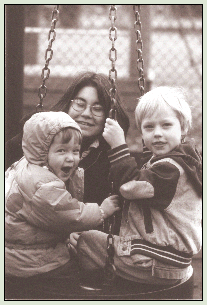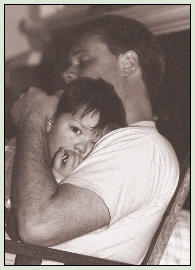
Section One
The Lesbian and Gay Child Care Task Force Needs Assessment
- Introduction and Purpose
- Hopes and Beliefs
- Methodology
- Appreciative Inquiry

with two dads and a little boy. One is Papa, the other is Dad.”
- Child Care Provider
Introduction and Purpose
Children and families continue to change and call for new responses of understanding and inclusion. We know that children experience exclusion and separation because of racial, language and developmental differences. In recent years, research and information have become more available in providing culturally relevant services for children of different racial, ethnic and cultural backgrounds. Yet most of us have little understanding of what challenges face children of lesbian, gay, bisexual and transgender (LGBT) parents. We are often at a loss when it comes to knowing how to include, support and provide resources to them. Diverse family structures such as these challenge our traditional paradigms of what should be. Often we aren't so sure how to respond and what to do to create a safe and caring place for lesbian, gay, bisexual and transgender parents, guardians and their children.
The Lesbian and Gay Child Care Task Force was formed in 1996 to address the needs of lesbian, gay, bisexual and transgender parents, guardians, educators and their children. It was modeled after the African American, Latino and the Asian/Pacific Islander Child Care Task Forces. These culturally specific networks are doing outstanding work to improve child care in their communities. The mission of the Lesbian and Gay Child Care Task Force is to support all children, families, and staff in early childhood and school-age programs in developing to their fullest potential by creating positive, supportive, and non-homophobic environments that are inclusive of lesbian, gay, bisexual, and transgender young people, educators, parents and their children.
The Lesbian and Gay Child Care Task Force reflects a broad spectrum of persons from diverse backgrounds and occupations. Members include state licensors, Head Start education coordinators, teachers, parents, public health nurses, directors, providers and other professionals.
 Significant accomplishments by the Lesbian and Gay Child Care Task Force include:
Significant accomplishments by the Lesbian and Gay Child Care Task Force include:- Providing information to families about “gay welcoming and gay friendly” child care programs in King County.
- Working in coalition with other groups and task forces to provide education and training around anti-bias issues, including racism, classism, sexism and homophobia.
- Developing and distributing culturally relevant materials and resources that help build positive, inclusive environments for educators, parents and their children.
- Creating a network of people who are committed to reducing homophobia in early childhood education and school-age communities.
- Researching the current reality of how well child care providers and early childhood educators are including and supporting lesbian, gay, bisexual and transgender parents/guardians and their children in order to enhance the quality of care for children and parents.
- Publishing this report on quality child care for LGBT families.
- There are an estimated three to five million lesbian mothers in the United States. Gay fathers number around one to three million.
- Eight to 12 million American children are currently being raised by lesbian and gay households. Approximately six per cent of the U.S. population is made up of lesbian and gay families with children.
Homophobic anecdotes in the early childhood and school age communities have been documented by the Lesbian and Gay Child Care Task Force. These incidents include:
- Refusal to accept children from lesbian, gay, bisexual and transgender families into child care.
- Biased attitudes expressed to children when they speak about their families.
- Demonstrated lack of understanding of the unique issues that children and LGBT families face on a day-to-day basis even when biased attitudes are not expressed or may not exist.
In the summer of 1998, the Lesbian and Gay Child Care Task Force made the decision to undertake a needs assessment to assess and enhance quality child care for lesbian, gay, bisexual and transgender families and children. Funding was sought and provided for this project by the City of Seattle Comprehensive Child Care Program, the King County Child Care Program and the Pride Foundation. The funding made it possible to hire a lead researcher and a team of eight researchers to design and facilitate the research project. Researchers went through a selection process with the primary goal of hiring a diverse and qualified team of persons. Researchers included teachers, providers, parents, vocational rehabilitation counselor, student labor organizer and preschool director. The ethnic cultures included two African Americans, one Asian Pacific Islander, one Latino and four European Americans.
 Hopes and Beliefs
Hopes and BeliefsThe hope and belief of this project is that the stories and findings, conclusions and recommendations will result in the following outcomes:
- Generate new openness to accepting children from lesbian, gay, bisexual and transgender families into child care programs of their choice.
- Cause caregivers and providers to desire and receive training and support in better serving children of LGBT parents.
- Inspire leaders to design and implement policies that clearly support and include lesbian, gay, bisexual and transgender parents and their children.
- Generate a level of responsiveness to LGBT family issues that will grow over time in the child care field.
- Widely distribute the research study to inspire other communities to do similar needs assessments.
Appreciative Inquiry begins by appreciating and valuing the “Best” of “What is” in order to move to “What might be.” In contrast, most other research models begin by identifying a problem and eventually moving toward action planning to solve the problem. The most prevalent change strategy of organizations and individuals is problem solving. Appreciative Inquiry, however, focuses not on solving a problem, but on realizing positive future visions. The following chart compares the two approaches:
Problem Solving Appreciative Inquiry Felt Need and Identification of Problem Appreciating and valuing the Best of "What is" Analysis of Causes Envisioning “What might be” Analysis of Possible Solutions Dialoguing “What should be” Action Planning Imagining “What will be” Basic Assumption: Basic Assumption: An organization is a problem to be solved An organization is a mystery to be embraced
(Adapted from David Cooperrider and Srivastva (1987) “Appreciative Inquiry Into Organizational Life” in Research in Organizational Change And Development. Pasmore and Woodman (EDS) Vol. 1, JAI Press by Sue Annis Hammond and Cathy Royal, PH.D in Lessons From the Field: Applying Appreciative Inquiry.)
Sue Annis Hammond explains the model well:
We take what we know and we talk about what could be. We stretch what we are to be more than what we have already been successful at. We envision a future that is an organization of the BEST. Because we have derived a future from reality, we know it CAN HAPPEN.
Appreciative Inquiry holds many advantages over traditional change processes. Steven M. Cato, in a paper entitled “Appreciative Inquiry: Positively Creating Organization Change,” concludes that:
- By describing a future that integrates personal as well as professional components, a vast amount of energy is created for change,
- Because the process is inclusive there is large scale buy-in to well-defined goals, and
- The process has a much higher tendency to build bridges between sub-groups than to build barricades. This avoids resistance to change that often is a part of the problem solving model.
The study consisted of 10 phases:
- Developing the research proposal
- Recruiting the research team
- Designing the interview questions
- Conducting interviews with child care providers and LGBT parents/guardians
- Transcribing interviews and stories of the “Best” that is
- Sharing information at a Community Summit and the 1998 WAEYC (Washington Association for the Education of Young Children) Conference to uncover themes and define compelling forces that create positive change
- Creating provocative propositions by engaging participants in visioning for the future - “Imagine a World . . . What Would It Look Like?”
- Recording personal actions and “Next Step” Recommendations that improve the quality of child care for lesbian, gay, bisexual and transgender parents and their children
- Publishing a report of the process and findings-including recommendations and resources for child care providers, community leaders and lesbian, gay, bisexual and transgender parents
- Broadcasting the findings and stories
The researchers brainstormed the following two questions: “What have you seen or experienced that has “worked” for children and LGBT families in the early childhood and school-age community?” and “What would we need to learn more about in order to improve the quality of child care for lesbian, gay, bisexual and transgender parents/guardians and their children?” As topics were identified we designed questions to allow participants in the study to respond with stories about these topics based on their own experience.
The topics explored were:
School Climate/Environment Policies/Procedures Curriculum Parent Involvement Resources "Out" Role Models Staff training Anti-bias Philosophy Parent Information Leadership
 The purpose of the interviews was to collect information from LGBT parents, guardians and child care providers about times when they experienced any of these aspects working at its best in their program. Through the interviews, researchers gained valuable information about what forces and qualities were present to make these positive things, events or actions happen.
The purpose of the interviews was to collect information from LGBT parents, guardians and child care providers about times when they experienced any of these aspects working at its best in their program. Through the interviews, researchers gained valuable information about what forces and qualities were present to make these positive things, events or actions happen.Different sets of interview questions were developed for child care providers and LGBT parents. Researchers were trained in interviewing techniques and in the art of appreciative interviewing. (Most of us are accustomed to looking for problems and talking about what doesn't work in an organization. An appreciative inquiry was new to all of us-researchers, as well as participants.)
The interview process began something like this:
Before we start I'd like to explain a little bit about what we are going to do because it may be different from other interviews. This is going to be an “appreciative interview.” I am going to ask you questions about times when you see things working at their “best” in your child care program. Many times, we try to ask questions about things that aren't working well-the problems-so that we can fix them. In this case, we try to find out about things at their best-the successes-so that we can find out what works and find ways to infuse more of it into everyday life for your child. It's also like what we do with children when we affirm their smallest successes and triumphs so that they will hold a positive image of themselves and then envision even greater possibility. The end result of the interview will enable us to understand the “life-giving forces” which provide vitality to child care. Do you have any questions?”A purposive sampling was developed to ensure the respondents represented a broad spectrum of LGBT families and child care providers. We made a concerted effort to include families of color, families with children with special needs and child care centers serving diverse populations of families and children. (Please refer to Appendix A and B to review the Participant Agreement Form and Confidential Information Form.)
The interview process not only served to gather information to help other child care providers and LGBT parents and guardians. It was a thought provoking and change-inducing experience for researchers as well. As stories unfolded and successes were shared, positive energy was created.
Some Interesting Data About the Study:
- Eight peer researchers conducted 44 interviews.
- Forty of the participants lived in Seattle, WA and 4 participants lived in King County, outside Seattle city limits. Three were from East King County and 1 was from South King County.
- Interviewees included 11 child care providers and 33 parents.
- LGBT parents included 4 gay men, 27 women who are lesbian, 1 transgender parent and 1 bisexual parent.
- The 33 LGBT parents interviewed included 28 co-parents, 4 single parents and 1 blended family made up of 2 dads and 2 moms.
- Two families had a child with special needs.
- Twenty-nine families had 1 child. Four families had 2 children.
- The ages of their children ranged from 11 months to 9 years of age.
- Thirty-five of the 44 family participants identified as European American. Other ethnic groups represented in this study were: African American (2), Latino (3), Native American (2), Japanese American (1) and East Indian (1).
- Eight of the 11 providers interviewed served large groups of children (30 to 110). Three providers served small groups of children (1 to 18). Forty-six percent of the children were of school age, 5 through 12; 21 percent of the children are preschoolers, ages 3 through 4 and 33 percent were infants or toddlers, ages 11 months through age 2.
- All providers served diverse groups of children including children from LGBT families.
Forty-four interviews were conducted, generating 167 stories in response to various questions and themes. Researchers read all stories and then through a directed process selected 24 stories in which strong themes were clearly present.
Wider Community Involvement
The 24 selected stories were presented at a Community Summit and at the 1998 WAEYC (Washington Association for the Education of Young Children) Conference.
The purpose of these presentations was to allow as many participants, child care providers and community leaders as possible to interact with the data and identify core themes, make recommendations and to imagine what these stories might mean for the future of child care.
The Community Summit included representation from child care providers and teachers; LGBT parents, guardians and friends; Safe Schools Coalition; Child Care Resources; Seattle/King County Public Health Department; Seattle Comprehensive Child Care Program; Seattle Human Services Department; ECEAP (Early Childhood Education Assistance Program); Office of Child Care Policy; S.T.A.R.S. (Washington State Training and Registry System) and the King County Child Care Program.
These two groups, plus the peer researchers and the members of the Lesbian and Gay Child Care Task Force reviewed the stories, identified the “Best” of what exists in child care for LGBT families, noted themes, developed provocative propositions, imagined the best possible future world for child care and defined next step initiatives as recommendations for ongoing action to support LGBT parents and their children.